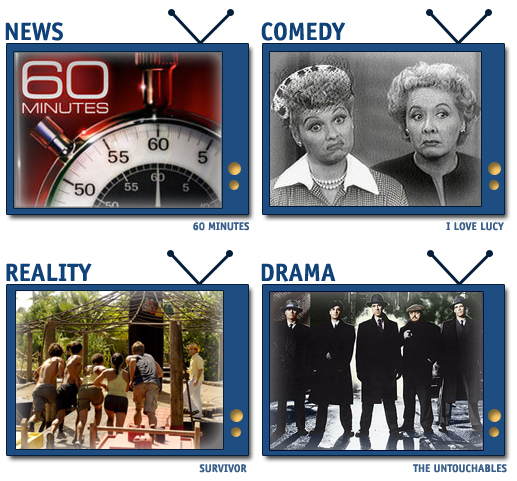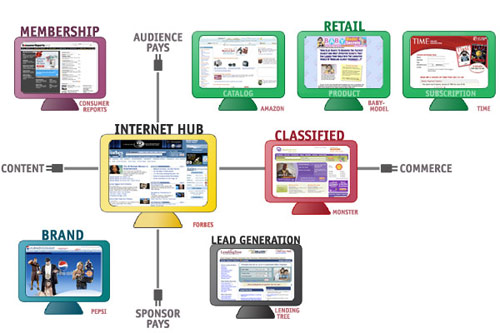Choosing the right business model and supporting infrastructure for any business is a key strategy for business success.
Mequoda uses the term “archetype” to help understand and categorize kinds of sites. An archetype is a pattern or design upon which all other similar things are patterned. The Mequoda Research Team has analyzed more than 2,000 media websites and concluded there are seven primary archetypes. Each of these seven archetypes has many sub archetypes that represent significant variations in information architecture on the primary theme.
Another common media platform to better understand the concept of a media archetype is television. Television is a media platform that was born in the 1940s. Early television shows were based on media archetypes borrowed from stage, film and radio.
Today, TV producers draw on a rich array of television archetypes that include situation comedies, reality shows, dramas and news magazines. Each archetype can be represented best by an actual show or a collection of shows that are best practice examples for the format, and the same can be done for websites.
Using Website Archetypes to Optimize the User Experience
Gas stations, supermarkets and bookstores are all retail businesses, yet the specifics of their business model and their physical infrastructure are very different. Building the right infrastructure supports higher revenue, lower operating costs and happier customers.
[text_ad]
Online publishing also supports different business models and each business model requires specific infrastructure to optimize the user experience, maximize revenue and keep costs low. Unlike a physical gas station or bookstore operator, the successful online publisher interacts with their customer in a virtual infrastructure. The nexus of this virtual infrastructure is called a website and is defined by its information architecture.
Archetypes and Sub Archetypes
Mequoda uses the term “archetype” to help understand and categorize kinds of sites. An archetype is a pattern or design upon which all other similar things are patterned. The Mequoda Research Team has analyzed more than 2,000 media websites and concluded there are seven primary archetypes. Each of these seven archetypes has many sub archetypes that represent significant variations in information architecture on the primary theme.
Before we dive into the seven media website archetypes, let’s use another common media platform to better understand the concept of a media archetype.
Television is a media platform that was born in the 1940s. Early television shows were based on media archetypes borrowed from stage, film and radio. Because many early producers came from radio, many early TV shows were radio with pictures—a familiar archetype that was not the best use of the new medium.
Today, TV producers draw on a rich array of television archetypes that include situation comedies, reality shows, dramas and news magazines. Each archetype can be represented best by an actual show or a collection of shows that are best practice examples for the format. Based on Nielsen Ratings, which use viewer popularity as a success metric, here are best practice examples for four television program archetypes:

60 Minutes (news), I Love Lucy (comedy), Survivor (reality show),
and The Untouchables (crime drama) are all archetypes for a specific
genre of television show. Each has a different information architecture that
supports the strategic intent of the show’s producers and the information and
entertainment needs of the show’s viewers.
The Seven Media Website Archetypes
Like all other mass media that came before them, websites are an evolving set of archetypes that represent the similar information architecture that can best meet similar user needs.
After reviewing more than 2,000 media websites, we’ve identified six unique archetypes plus a seventh hybrid that combines features of two or more of the six unique archetypes into a common user interface. Together they are the seven Mequoda Website Archetypes that we now use to set best practices for all media websites.
Each archetype also supports a unique business model or method of generating revenue. Matching the right archetype to the right business model is key to online publishing success. If the archetype and the business model are not in sync, success is limited. In fact, of the more than 2,000 media websites surveyed, the vast majority of those websites are contributing less than 10 percent of total media brand revenue for 2006.
In this report, we will look at the media websites that are generating more than 10 percent of total brand revenue to illustrate the seven archetypes identified by the Mequoda Group as best practice archetypes. We’ll also look at a number of sub archetypes and, finally, we’ll review how the most advanced online publishers are building website networks that use multiple archetypes and business models to maximize their online publishing revenues.

The seven Mequoda media website business models are derived from this two dimensional analysis that asks two simple questions:
Who pays for access to content, the audience or the sponsors?
What does the user seek, content or commerce?
Each of the computer screen graphics represents a Mequoda media website hub or satellite archetype.
Evaluating Success
In the next several chapters we will explain each of the Mequoda archetypes and offer best practice examples. You’ll notice that for each specific example we offer visitor statistics from Compete SnapShot to measure website traffic in terms of U.S. unique monthly website visitors. We also use Yahoo! Site Explorer to report website pages and inbound links from other websites.
About Compete SnapShotTM
Provides free information for every site on the Internet including site traffic history and competitive analytics; a list of available promotional codes across thousands of online retailers; and site-specific trust scores based on up-to-the-minute data from Compete and third party security services.
About Yahoo! Site Explorer
Provides website page counts at the domain and site-wide basis plus links from other web pages—both internal and external. The web pages reported are from the entire domain and links reported are for external inbound links from other publishers’ websites.
This article was written by Don Nicholas with the help of Peter A. Schaible. It is only one part of a series on Internet Business Models. See below for the rest of this series:



Generally I do not learn article on blogs, however I would like to say that this write-up very compelled me to take a look at and do so! Your writing taste has been surprised me. Thanks, very great article.
Great post – Just subscriped to your RSS feed.. Thanks